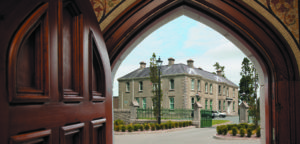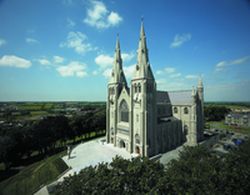MASS OF THANKSGIVING FOR THE
BEATIFICATION OF THE BLESSED JOHN PAUL II
WITH PILGRIMS FROM IRELAND
CHURCH OF SANTA MARIA IN DOMNICA ALLA NAVICELLA, ROME
HOMILY BY
CARDINAL SEÁN BRADY
2 MAY 2011
*If we had listened to Blessed John Paul’s warnings about excessive greed more carefully and taken to heart his pleas for an end to violence more urgently, some of the worst effects of our current economic crisis and the needless pain of our violent past could have been avoided.
*Blessed John Paul’s heroic witness of faith, love and apostolic courage, accompanied by great human charisma … helped believers throughout the world not to be afraid; not to be afraid to be called a Christian, not to be afraid to belong to the Church or to speak of the
Gospel.
*In Blessed John Paul’s consistent ethic of respect for life at all its stages and the peaceful pursuit of justice and human rights, I believe we will find a light for our path to a more friendly and peaceful future between all the people of our island and of the world.
I welcome you all, pilgrims from the Church in Ireland, to this Mass of Thanksgiving for the beatification of the Blessed John Paul II. At this special time I wish, in particular, to extend my good wishes to the Polish community living in Ireland and to acknowledge their vibrant contribution to the Church at home and throughout the world.
In the words of the special prayer for the Beatification, we are here to thank God for having given Pope John Paul II to the Church and for having filled him with the tenderness of the Father, the glory of the cross of Christ and the splendour of the love of the Holy Spirit.
As pilgrims from Ireland we are here to give particular thanks for the vision and hope of an extraordinary man, an outstanding disciple of Jesus Christ who came to the shores of our own land as a pilgrim in 1979. He came at a decisive moment in the history of Ireland, a
decisive moment in terms of:
– our search for peace in the North;
– our response to materialism in our society and the ‘Celtic Tiger’
that was to emerge, and;
– our approach to the very future of the Christian faith and heritage
of our country.
As we look back at those momentous days, it is extraordinary to realise just how prophetic, just how important and far-seeing his message was to us at that time. Perhaps if we had listened to his warnings about excessive greed more carefully and taken to heart his
pleas for an end to violence more urgently, some of the worst effects of our current economic crisis and the needless pain of our violent past could have been avoided.
Pope John Paul II came to us in the very first year of his Pontificate, the third country he visited including his native Poland. He visited us in September and October 1979 on his way to the United States where he gave his first address to the United Nations. That was an address focused on his often repeated hope for a new era of peaceful resolution of conflict in the world. At this stage he had already established the tradition of mentioning the countries he had just visited at his next Wednesday audience in Rome. On his return to Rome on this occasion however he made mention of Ireland and, in particular, of the deep impression left on him by his visit to the ancient monastic ruins at Clonmacnois. It was from here that so many Irish missionaries had set out to bring the light of Christ to a darkened Europe, a Europe in need of a new heart and a new spirit, a Europe in need of a new vision of life and culture, a Europe in need of sound reasons to hope.
The missionaries from Clonmacnois had travelled as far as Kiev and Poland. Blessed John Paul was always deeply grateful for the contribution of the Irish Church to the Christian faith of his own country and of so many other countries across the world. He was also very conscious that like the Church in Poland, the people of Ireland had not abandoned their faith in the face of centuries of persecution. He repeated that gratitude and affection when only a few months after his visit to Ireland he visited the community of the Irish College here in Rome.
Today, in this Mass, we return that appreciation and that thanks. In his short address at Clonmacnois he said of those who had implanted and kept the faith alive in Ireland that ‘When we look at the works of faith, we must give thanks to God’. We give thanks today for what the
Holy Father, Pope Benedict XVI, described yesterday as the ‘Titanic faith’ of Pope John Paul II. We give thanks for the role John Paul II played in strengthening the faith of so many people across the world.
Blessed John Paul helped to strengthen faith in so many ways. He did it, for example, through the immense legacy of his thought and teaching. No Pope in history has left such a legacy. There are his own books both before and after he became Pope. Then, as Pope, he wrote 14
Encyclicals, 39 Apostolic Letters, gave hundreds of audiences and other addresses, oversaw the compilation of the ‘Catechism of the Catholic Church’ and the ‘Compendium of the Social Doctrine of the Church’, and so much more. It will take many years for the content of the life and teaching of John Paul II to have its full impact on the life of the Church.
However, as Pope Benedict said at the Beatification yesterday, it was most of all by his heroic witness of faith, love and apostolic courage, accompanied by great human charisma that this exemplary son of Poland helped believers throughout the world not to be afraid; not to be afraid to be called a Christian, not to be afraid to belong to the Church or to speak of the Gospel. By his own example of fearless courage in witnessing to Christ as the life and hope of the world, he helped us not to fear the truth. He knew that the truth of Christ is the key to the truth of the human person and therefore the key to freedom, justice and peace for the world.
He spoke this ‘whole truth about the human person’ with love. It was a truth he discovered in intense study, prayer and contemplation – a truth which he communicated with love and joy through his whole personality – a truth he spoke of fearlessly in season and out of season.
We remember with gratitude the outstanding witness of his life. We remember those defining words of his ministry – ‘Do not be afraid – throw open the doors to Christ!’ – spoken from the balcony of St Peter’s just after his election; we remember the search for renewal and hope in our own land and the wise direction he gave us when he visited our land.
We commend to the heart of Blessed John Paul, now in heaven – the needs of our country and of the Church in Ireland which he carried so often in his heart here on earth. Just as he came among us at a decisive moment in our history, thirty two years ago, we ask him to inspire and guide us to the way of Christ – to the way of freedom, hope and renewal – as we face the decisive moment that faces our country and our Church today.
In his presentation of the Church’s social teaching, in his prophetic presentation of the path between the excesses of communism and capitalism, in his prioritisation of the dignity and service of the person, I believe we will find some useful direction for the future progress of our national and international economic framework as we face a period of recession.
In his consistent ethic of respect for life at all its stages and the peaceful pursuit of justice and human rights, I believe we will find a light for our path to a more friendly and peaceful future between all the people of our island and of the world.
In his emphasis on the universal call to holiness, lived out in intimate personal union with Christ and in the ordinary, every day means of the Christian life, including prayer, service of others and the sacraments, I believe we will rediscover the authentic interpretation of the Second Vatican Council and the path to genuine, effective renewal in the Irish Church. That renewal will not be found first and foremost in ‘management-speak’, in a sociology of the Church or in radical departures from the deposit of faith but in a change of heart, in personal and communal conversion and total commitment to the tried and tested path to holiness in the sacraments, fidelity to the teaching of the Church and to prayer. This is the unapologetic, fearless witness of John Paul II and of his successor, Pope Benedict XVI.
At the Beatification yesterday, I noticed at one stage a large flag from the city of Wadowice in Poland, the birthplace of Pope John Paul II. I had the pleasure of visiting Wadowice at one stage and the Church where John Paul was baptised. I also remember a photograph of John Paul praying with great intensity and gratitude at the font of his Baptism in Wadowice. It is a reminder to us all of a central message of the Second Vatican Council, a Council which Karol Wotyla attended. It is that our baptism calls and empowers all of us to be saints – to become the blessed of God.
If we lose sight of this and of the generous, everyday means God has given us in his sacraments, in the Word and in the teaching of his Church to achieve holiness then our search for authentic renewal of the Church in Ireland will be in vain. If we lose sight of our earthly pilgrimage as a journey towards our eternal future and of our closeness to the Church in heaven – to the Blessed, the saints and the angels – then we will lose sight of an immense and vital grace we need and have to guide and sustain us through the difficult challenges that no doubt lie ahead – as a Church and as a country.
Today, we give thanks that the Church has confirmed for us that Ireland has yet another friend in heaven in the person of Blessed Pope John Paul II. By setting holiness as the gold standard of the ordinary Christian life, he has shown us the true path to renewal and the way to eternal communion with the Blessed Trinity. Joachim Navarro Valls told us at the Vigil on Saturday evening that Blessed Pope John Paul II went to confession every week. He put his trust totally in the infinite mercy of God and in the Maternal Intercession of Mary. In this he gave us a living image of Jesus the Good Shepherd. We commend the Church in Ireland to his continued guidance and intercession, with St Patrick, St Brigid and all the saints of Ireland – the saints of
our venerable Christian past – and in the hope of the many saints of Ireland yet to come.
Amen


